Visiting Dubai had never been high on my travel wish list. I didn’t even expect to like it. Not a fan of big cities to begin with, I figured it would be noisy, crowded, pricey, and impersonal. My assumptions were based on the stories I’d heard about this city of excess. In 1965, when the United Arab Emirates (UAE) gained independence from Britain, the site where Dubai now rises was little more than a fishing village on the banks of the Dubai Creek. But with the discovery of oil a year later, a modern city began to emerge from the barren Arabian Desert. When Sheikh Mohammed bin Rashid Al Maktoum became the ruler of Dubai in 2006, he set about make Dubai bigger, better, taller, faster – a city of superlatives that is today unrivaled on the planet.
Let’s Begin With Tallest…
More than just a city of skyscrapers, Dubai is home to the 2,716.5-foot high Burj Khalifa. Not only does it claim bragging rights as the tallest building in the world, it is also the tallest free-standing structure in the world, has the largest number of stories in the world (according to their website, “more than 160”), has the highest occupied floor in the world, the highest observation deck in the world, the tallest service elevator in the world, and its 57 elevators have have the world’s longest travel distance from lowest to highest stop.

The spiraling “Y” shape of the Burj Khalifa is an aesthetic wonder, but the design is functional as well, reducing wind forces on the tower. The building is topped by a 700-foot telescoping spire comprised of more than 4,000 tons of structural steel. It was constructed from inside the building and jacked to its full height using a hydraulic pump. The exterior of the Burj Khalifa is clad with reflective aluminum and stainless steel panels, into which 26,000 individually hand-cut glass panels were fitted.
While visitors are welcome to visit the observation decks located on levels 124/5 and 148, it is the exterior that most excites tourists. Wherever the tower is clearly visible on the skyline, there is sure to be someone posing in front of it. The only difficulty is finding a spot from which to capture its entire soaring height as well as the person standing at its base.

Dubai is a virtual Disneyland for architects, who come from all over the world to view its unique skyline. According to Emporis, a global provider of building information, there are 1,339 high-rises, 545 skyscrapers, and 492 low-rises in the city. At first sight, I was reminded of the great skylines of the world: New York, Bangkok, Shanghai. After a few days, I began to sense something different in the feel of Dubai’s architecture, but I couldn’t quite put my finger on what that difference was. It finally clicked into place when I recalled that Islam prohibits using images of sentient beings. Only geometric and calligraphic designs are permitted, as they represent the infinite world of Allah beyond the material and physical world.

A surprising number of Dubai’s skyscrapers have been built as twins, including Damac’s Dubai Park Towers, which earned “world’s best” designation in the mixed-use development category at the 2012 International Property Awards in London.


Moving On to the Best…
Second only to the Burj Khalifa in magnificence is the Burj Al Arab Hotel. Regularly trumpeted as the most luxurious hotel in the world, it was designed in the shape of a billowing Arabian dhow sail to commemorate the nation’s seafaring heritage. Construction, which began in 1994, involved 3,000 companies and contractors and 250 designers from the UK, USA, and Dubai. Just reclaiming the island upon which it sits took two years, and a further three years were required for construction of the hotel.
Frankly, I struggled with whether to include this development in the “tallest” or the “best” category. At 1,053-feet high, Burj Al Arab is the tallest all-suite hotel in the world. It is also the tallest single structure on a man-made island. It is higher than the Eiffel Tower and just 198 feet shorter than the Empire State Building.
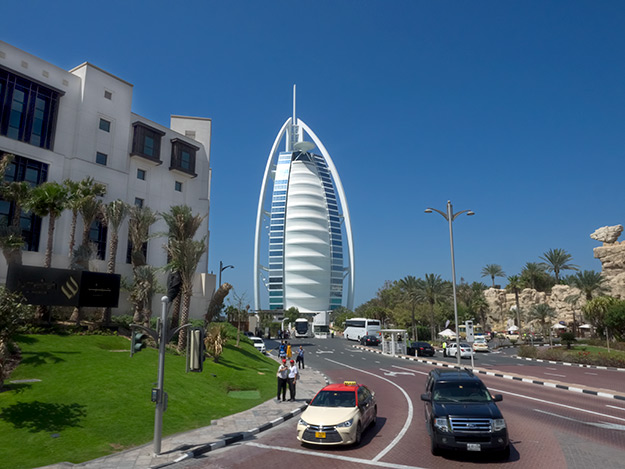
In the end, I bowed to the “best” designation. Burj Al Arab contains 202 duplex suites, which range from 1,830 square feet to an almost incomprehensible 8,396 square feet in size. Every suite enjoys breathtaking views of the Arabian Gulf through floor-to-ceiling windows with electronically controlled drapes. Luxurious in-suite appointments include a pillow menu with 17 options, complimentary Hermès amenities, iMacs with wireless internet access, videos on demand, 42″ plasma television screens, and a minimum of 14 phones (27 in the Royal Suites).
Guests are also provided with a 24-carat gold iPad upon check-in, which serves as a “virtual concierge,” but personal service is not limited to electronics. A dedicated reception area is located on each floor, and check-ins are conducted in the privacy of each guest’s suite. Butlers are in attendance 24-hours per day to address the needs of each guest. With more than 1,600 staff members, the Burj Al Arab has a staff-to-suite ratio of 8:1, one of the highest in the world.

The hotel boasts one of the world’s largest fleet of Rolls Royces available for airport transfers or sightseeing around Dubai. With its private helipad, the property also offers exclusive helicopter transfers to and from Dubai International Airport. The helipad, which juts prominently into space near the top of the tower, has been the site of many promotional events. In 2005, Roger Federer and Andre Agassi played a friendly match on it and both Tiger Woods and Rory McIlroy have teed off from it. Chinese world number one table tennis players Long Ma and ShiWen Liu faced off in the first ever table tennis tournament to be held on a helipad.
Burj Al Arab officially opened its doors on December 1, 1999 and has been considered the second most popular architectural site to see when visiting Dubai ever since. But don’t expect to walk casually through the front door. Access is limited to paying guests. There are, however, ways around the restriction. Lunch or dinner at one of the hotel’s six restaurants will provide access to the common areas, though any of them might set you back a hefty amount. The most economical way to get a peek at the lavish hotel is to make a reservation for afternoon tea or a sunset cocktail in the Skyview Bar on the 27th floor. Those who choose cocktails will be treated to “mixology,” the hotel’s unique concept of creating personalized cocktails to suit guests tastes and mood. Afternoon tea will set you back a mere $169 per person. Cocktails? I shudder to think.
and the Biggest…
Shopping is one of the most popular activities when visiting Dubai, and with more than 60 malls to choose from, the city aims to please. Foremost among the centers is Dubai Mall. With an internal floor area of 5.9 million square feet and 3.77 million square feet of gross leasable space, it offers more than 1,200 retail outlets, 200 food and beverage outlets, and an array of entertainment and leisure attractions.

The latter include the Dubai Aquarium and Underwater Zoo, with its 270-degree walk-through tunnel; a 76,000 square foot, high adrenaline indoor theme park; a 22-screen cinema megaplex; the Olympic-sized Dubai Ice Rink, and a massive indoor waterfall adorned by bronze sculptures of divers. Visitors come from all over the world to shop in Dubai, and each year more than 80 million of them visit Dubai Mall.
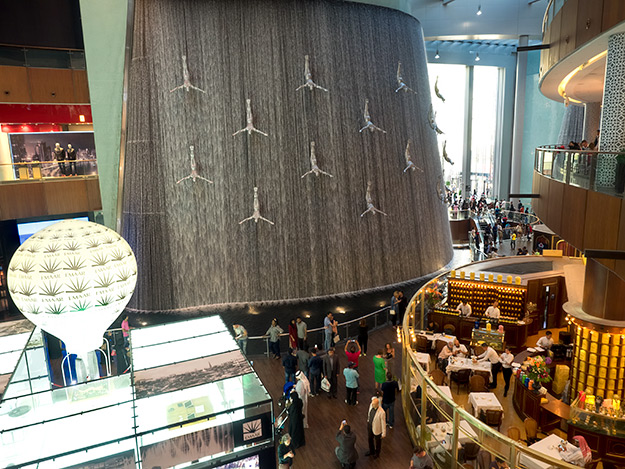
With only 2.4 million square feet of floor area, Mall of the Emirates comes in a distant second to its grander cousin. However, as home to Ski Dubai, the Middle East’s first indoor ski resort and snow park, it is perhaps more famous than Dubai Mall. Ski Dubai is not the worlds biggest indoor ski facility; both the Netherlands and Germany have larger ones. However Ski Dubai does claim to have the longest indoor ski run in the world, and considering that the mercury regularly tops 110 degrees Fahrenheit in the summer in Dubai, it is definitely the world’s most unique.

Despite its smaller footprint, Mall of the Emirates is only slightly smaller than the largest mall in the U.S. (King of Prussia Mall near Philadelphia). Dubai’s number two mall contains an impressive 630+ retail outlets, more than 100 restaurants and cafes, 80 luxury stores, and 250 flagship stores. And even if, like me, you’re not much of a shopper, it’s worth a visit to see the mall’s stunning center court.
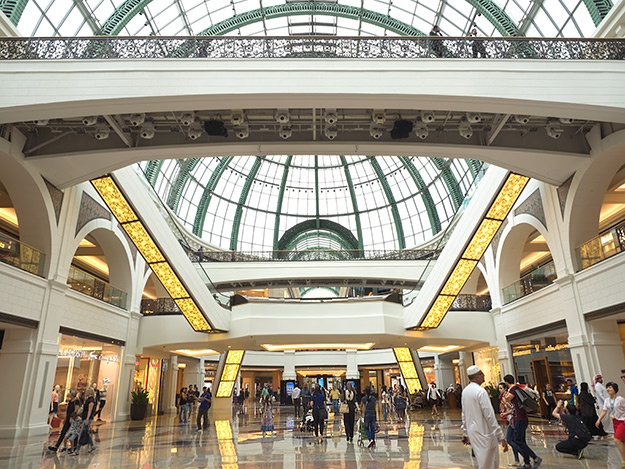
Dubai also has the world’s biggest indoor theme park, IMG Worlds of Adventure; and the world’s largest inflatable water park, Aqua Fun. The Emirate has also announced plans to build the world’s biggest airport over the next 12 years and the world’s largest solar energy park by 2030. Deira Night Souq, the world’s largest night market, is scheduled to open by the end of 2018.
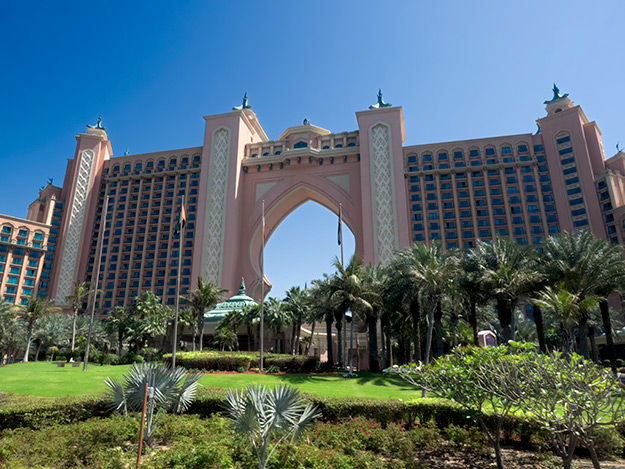
While not technically the biggest man-made island in the world, Dubai’s Palm Jumeriah deserves an honorable mention. The sixth largest on the planet, this artificial archipelago is shaped like a giant palm tree. It is comprised of a 1.2-mile long trunk, from which sprout 17 fronds, topped by a surrounding crescent. The much-touted Atlantis The Palm Resort, with its immense aquarium and undersea suites, sits in the center of the crescent like a crown jewel.
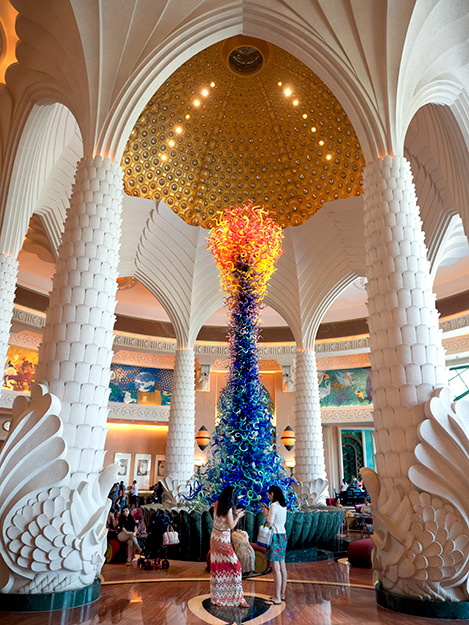
and finally, the Fastest…
In addition to pursuing the tallest, biggest, and the best, Sheikh Mohammed bin Rashid Al Maktoum seems to have a need for speed. Dubai police are equipped with 14 super-speedy patrol cars, including their latest addition, a Bugatti Veyron that can reach speeds of 253 MPH and go from 0 to 60 MPH in just two-and-a-half seconds. The Bugatti was recently declared the fastest police car in the world. Though some say the fleet is needed to chase down wealthy Emiratis who race around town in powerful sports cars, the reality is that most of the patrol cars are used for public relations purposes.
Dubai also recently added five Mustangs worth more than $50,000 USD each to their ambulance fleet. The vehicles have been modified to reach speeds up to 185 MPH making them the fastest ambulances in the world. They are equipped with basic medical equipment required for emergency calls and will be stationed in major tourist hubs or wherever large festivals and events are occurring.
But racing is where Dubai gets serious about speed. With the patronage of the Crown Prince Sheikh Mohammed, the Dubai Autodrome was opened in 2004. In addition to hosting world class racing events, the Autodrome offers non-professionals an opportunity to try out their skills on the race course. For as little as $238 USD, tourists visiting Dubai can take laps in a McLaren Sprint, Formula DXB, Audi R8 V10, or seven other souped up makes and models.
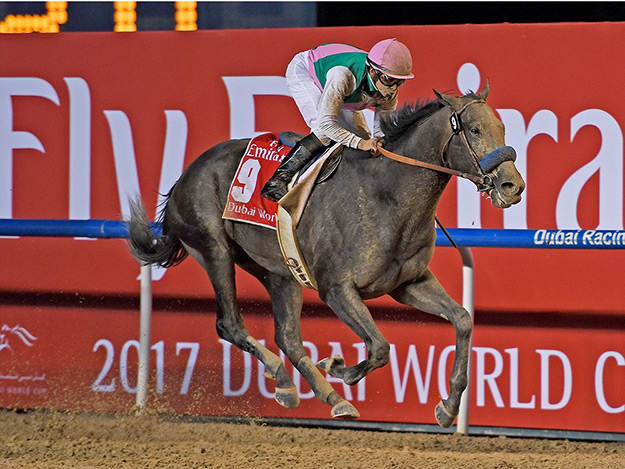
The Sheikh’s interest in motorsports is superseded only by his love of horse racing. As a young boy, he realized his talent for gentling and training horses. He spent many happy hours riding bareback on the sands of Jumeirah Beach at breakneck speeds. In 1992, he founded Godolphin, a global thoroughbred breeding and horse racing team and in 1996 arranged for the first Dubai World Cup to be held.
Since becoming the Crown Prince and leader of Dubai in 2006, the Sheikh has worked to make the Dubai World Cup into one of the premiere horse racing events in the world. In 2010, he introduced racing fans to Meydan, the world’s largest integrated racing facility, which has grandstand seating capacity for more than 60,000. He also increased the purse to $10 million, making it the world’s richest horse race. That ranking was recently eclipsed when the Pegasus World Cup in Florida offered a purse of $12 million. Not to be outdone, the Sheikh has promised that he will up the ante for the next Dubai World Cup.
…While Still Preserving History and Tradition
With all the glitz and glamour that makes up today’s Dubai, I wouldn’t have been surprised if the historic, traditional elements of the city had disappeared. I was pleasantly surprised that this was not the case. I stayed in the Deira neighborhood, a short walk from Dubai Creek. The tiny fishing village that blossomed into Dubai began on the shores of this sleepy salt water creek. Thankfully, today it is still possible to get a feel for those early days. Shuttling between the two sides of the creek is easy and fun, and a ride costs the equivalent of 27 cents. Small motorized water taxis called Abras run back and forth continuously, with one departing every few minutes.

The home of Sheikh Saeed Al Maktum, ruler of Dubal from 1912 to 1958, still stands on the Bur Dubai side of the creek. Today it is a museum, best known for its exquisitely preserved wind towers, a traditional architectural element that kept houses cool. Just steps away, the Heritage and Diving Living Museum explores the history of Dubai’s historic pearl diving industry and features traditional potters, weavers, and other craftsmen. A bit further upstream is the Bastakia Quarter, which was settled by traditional Persian merchants late in the 19th century. Other than pedestrianizing the streets, the area appears much the same as it did in the late 1800’s.
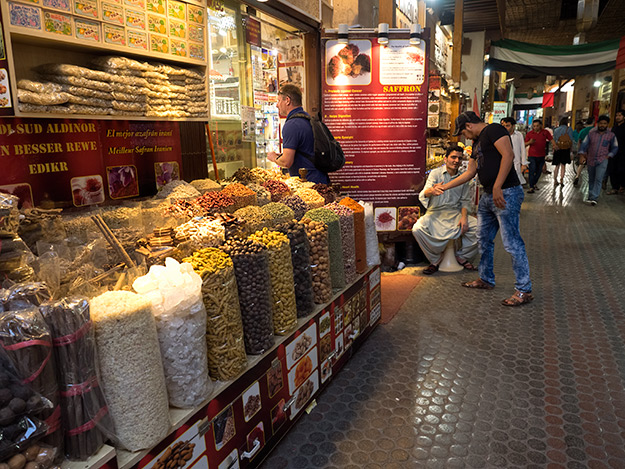
The Deira side of the creek is a wonderland of traditional souks (markets), where gold, spices, fresh fish, and even perfume are still hawked. Just strolling along the wharves is like riding a time machine into the past. Immigrants load down creaky old wooden cargo dhows with mountains of merchandise and sail off to far-flung destinations, as they have for centuries.
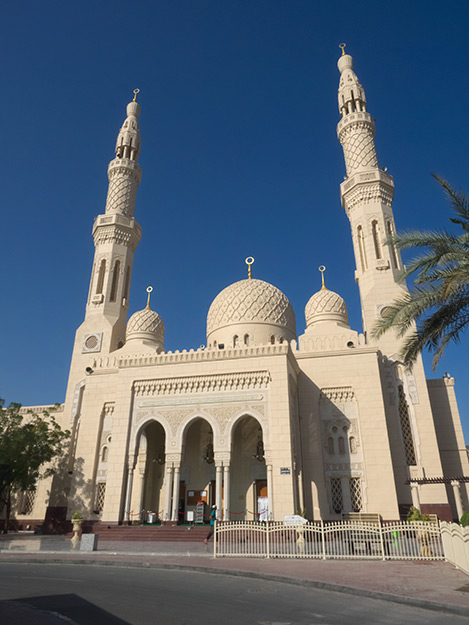
I was also delighted that Jumeirah Mosque was open to non-Muslims for tours that begin at 10 every morning except Friday (be there by 9:45 a.m.). I arrived in plenty of time to fill up with plump, moist dates and mint tea before the tour began. The first stop was a water fountain where worshipers perform ablutions before entering the mosque to pray. Our guide invited eight of us to sit down at the faucets while she walked us through how and what must be washed, and in what order.
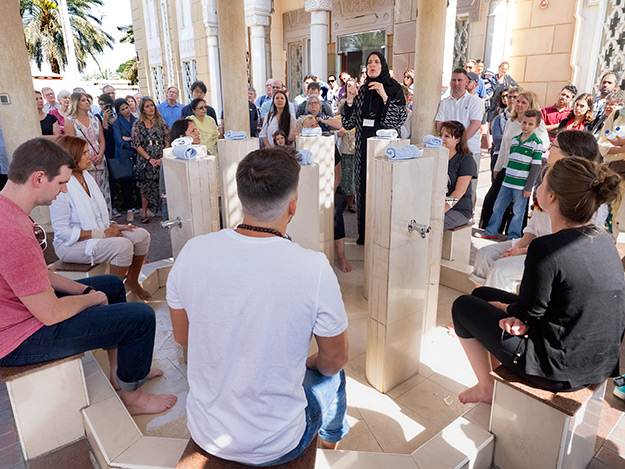
Inside the prayer hall, she told us about the history of the mosque and explained the basic precepts of Islam, then invited us to ask anything. And we did, for more than an hour. It was fascinating and cost only 20 Dirhams, or slightly more than $5 USD. I highly recommend the experience.

The Final Verdict:
Visiting Dubai was one of the biggest surprises of my ten plus years of travel. I’m not a shopper, I don’t go googly-eyed over luxurious hotels, and I’m not much of a sports fan. So why did I like it so much? The city never felt overly crowded, people were exceptionally friendly, it was extremely easy to get around, and prices were surprisingly affordable. But more than that, I couldn’t not be impressed by the glittering oasis that Sheikh Mohammed has created on a desolate strip of sand, seemingly out of sheer force of will and an inspired vision.

Another part of Living in Dubie is dealing with a multicultural town which is not really easy. anyway great blog
Thanks Bernardo
Wow. there are lots of things to visit in Dubai, I wish I could travel to Dubai soon.
I love the fact that Dubai is such a city of contrasts. The architecture is stunning, but my favourite part of the city is the Deira side. Walking through the souks is like an Aladdin’s cave and the smell of the spices transports me to exotic lands.
Hi Janine: I actually stayed on the Deira side and, like you, loved it. It offers a fascinating glimpse into the past.
Nice Barbara, your story from UAE was like you`d walked in my footsteps. And yes, Dubai along the river was the most charming part – and coolest.
Thanks for the compliment, Claes. Glad you liked my story – we had similar experiences.
This has to be the best article about visiting Dubai that I have ever read. What a fantastic experience this must have been. I would love to visit some day. I have several friends who are bit put off by all the sleek buildings and glitzy malls, but architecture and design appeals to me as much as history and culture so I think I would love every minute.
Hi Sharon: Thanks so much for your kind compliment. I know many people who, as you say, are put off by the glitz and glamor. But I looked at it differently I was quite amazed by what they’ve been able to create on a barren strip of sand.
Wow. I dream of going there and this post just made me travel there….
You should create a million eyez photobox btw…. millioneyez.com and ask people to upload their photos of Dubai and then embed it into this post. Just an idea…
I love your posts Barbara, and I really liked this one on Dubai, we used a 9 hour stop over on the way back from a wedding in Zambia in 2015 to explore and it was perfect. As you say really easy to exit the airport and get around – we arrived at 7am we were quickly at the Burj Khalifa and were surprised that at 10am there were no queues, so we managed to go straight to the top to take some amazing photos of the whole city. Did you go to the top? We then came back into the Dubai Mall to wander around the shops and have a costa coffee before taking the metro back to the airport it was so easy and gave us a chance to see a city we may not otherwise have seen. If any of your readers are considering doing this on a stopover I would strongly recommend it as it was so easy to get around. Many thanks for your posts…..and happy travelling! Mari
Thanks so much for your comment Mari. I didn’t think to recommend that people with long layovers tour the city, but it’s a great idea.
Excellent article, Barbara! I really enjoyed it and learned a lot. I never had interest in traveling here, but am now intrigued. Thank you.
Thanks so much Crystal. See you’re still hard at it in the gym back home. You’ve got lots more discipline than me.
Excellent article. I just returned a week ago from that area. I loved every minute of my visit. It was so refreshing in every way. Beautiful women and girls dressed so conservative, with smiling faces and expensive clothing. No crime there or drugs and everyone entering the country is checked and when finding a job is told how long they have to stay. Very controlled. Loved it all.
Somebody more affortunate who has mercy and pay a trip for myself and my grandouther to that wonder world!
Thanks for sharing Barbara. We visited Dubai in 2015 and saw most of the sights you listed. We really didn’t know what to expect before we went and were thinking that we wouldn’t like it. How wrong we were it’s a fascinating city. Bit over the top but that’s part of it’s charm.
It is a bit over the top, but as you say, that’s part of the experience. I’d actually like to go back to see more!
Wow. That would be the city of my dreams I’d like to visit one day
It’s pretty amazing Elias. Hope you make it there one day.